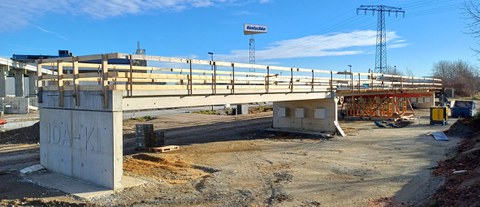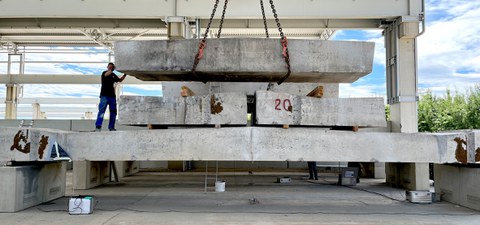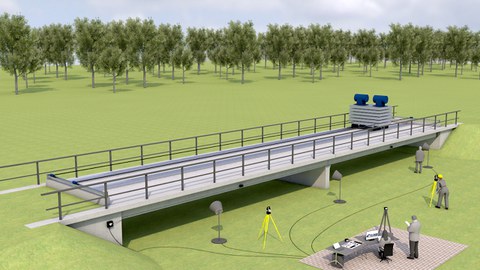Automated assessment of monitoring data
Table of contents
Project data
|
Titel | Title |
Report from the 2023 yearbook
A research bridge in Lusatia

Construction status of the openLAB in December 2023
A digital twin is a virtual image of a real object. Measurement systems can be used on engineering structures, such as bridges, to provide information on the condition of the structure at any time. In future, it will be possible to detect damage to the structure at an early stage in order to prevent consequential damage and any resulting traffic restrictions. However, due to a lack of approaches for automated data analysis and evaluation, the large volumes of data to be processed currently pose a challenge.
This is where the IDA-KI project consortium comes in. Evaluation methods are being developed that enable reliable differentiation between measurement errors and damage to the structure. For validation purposes, load tests are carried out on a 45 m long research bridge - openLAB - up to the severely damaged state. The real database created in this way contains characteristic signals on damage to the structure, measurement errors and information on the structure in the undamaged reference state under real environmental conditions.
Some of the openLAB sensors were installed in the formwork before the precast prestressed concrete elements were concreted so that monitoring could be carried out from "hour zero". The suitability of the measurement technology was tested in preliminary trials. Of particular importance is the use of distributed fiber optic sensors (DFOS), which form an artificial nervous system of the bridge with a total length of almost 1 km. The fiber optic sensors enable quasi-continuous strain measurement, from which, for example, information on the degree of prestressing or possible crack formation can be derived. The "fosanalysis" program library was developed for semi-automated evaluation of the large data sets, which is available as free software and is being further developed as part of the project. All status information, including the identified damage, is provided in an easily consumable as-maintained model.
The openLAB is scheduled for completion in February 2024 and will also be made available to external research groups who wish to test and validate sensor and monitoring techniques. Collaborations with the mFUND projects smart_tendon and ANYTWIN are already in place.
Report from the 2022 yearbook
Big data? Smart data!

Preliminary tests on old bridge girders – installation of the permanent load
Infrastructure structures are subject to constant ageing, which is why their condition must be inspected manually at regular intervals. Only when damage is detected during the regular structural inspection is a maintenance measure planned. This reactive approach means that damage often remains undetected for a long time, resulting in increased renovation costs. In future, this problem-oriented approach is to be replaced by data-based, forward-looking and predictive maintenance management. The basis for reliable condition assessment in near real time is structural monitoring. However, current monitoring applications require time-consuming manual evaluation, whereby ageing of the measuring system or measurement errors are difficult to detect.
The IDA-KI project uses machine learning to develop fully automated evaluation algorithms for monitoring data and integrate them into a cross-life cycle monitoring concept from hour zero. The algorithms have already been successfully trained for a real bridge data set. For fault detection and correction, the system checks which sensors correlate with each other. If one sensor shows strong deviations compared to its "partners", this is an indication of a measurement error. The analytical redundancy approach eliminates the need for additional redundant sensors or a numerical model.

Visualization of the real-life laboratory
A model bridge is currently being planned, which will be equipped with sensors, e.g. fiber optic sensors, during construction. This will allow the monitoring concept and the evaluation algorithms to be validated in fast motion. Load tests and damage to redundant measurement technology in a targeted manner will create a real database for the first time, which will make it possible to differentiate between measurement errors, influences from the ageing of the measurement system and structural changes to the building in the future. Condition indicators should enable intuitive interpretation of large amounts of data. The demonstrator structure, which is being built in Bautzen, will be expanded as a real laboratory and will also serve as a place for scientific exchange in the coal region after the project has ended.
